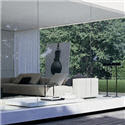 Frottage 1 - 24" x 36" Mixed Media Painting: Pastel, Acrylic, Gesso on Glassine
Frottage 1 - 24" x 36" Mixed Media Painting: Pastel, Acrylic, Gesso on Glassine For this summer's program of continuing education (last summer I studied Architecture in Italy), I have embarked on a course in 'Mixed Media Painting Techniques' at Emily Carr University of Art. The course teaches the process of image-making on built surfaces and works with a range of materials such as gesso, plaster, paint, ink, charcoal, and various papers. I am learning to explore 'expression and emotion' through layering, drawing, brushwork, Frottage and Grattage following in the footsteps of the greats in mixed media painting like: Max Ernst, Mark Rothko, and Paul Klee. I particularly like my teacher, Diana Kubicek's style of teaching. She teaches us to explore the various techniques fearlessly and says repeatedly there are "no mistakes"in painting. As a matter of fact "mistakes can be the building block of a great masterpiece". I like that! I have always been interested in drawing and sketching since my days in Design School, but find that I never have the time to take a brush to paper and do larger abstract paintings and works of art. So this course is a perfect opportunity to allow myself the freedom to explore different mixed media painting techniques. The last class we spent exploring the technique of Frottage (from French frotter, "to rub") a surrealist and "automatic" method of creative production. Frottage was developed by Max Ernst.

Frottage 2 - 18" x 24" Mixed Media Painting: Ink, Acrylic & Pastel on Paper
Frottage Painting 3 - 18" x 24" Pastel on tracing paper
Frottage Painting 4 - 12" x 18" Mixed Media Painting: Acrylic & Gesso on paper
In the first class we explored the technique of mixed media painting starting with a base of Gesso
Study 1 - 11" x 14" Mixed Media Painting Technique: Gesso, Acrylic and Watercolor on Card Stock
Gesso is an art supply used as surface preparation or primer for painting and sculpting. Gesso is believed to have been developed in Italy, since the word gesso is Italian for 'chalk'. Preparation varies according to intended use, but usually consists of mixing glue with plaster, chalk, or gypsum. (Gesso is the perfect base for starting a mixed media painting.)
Gesso resembles paint, but is thinner and dries hard. Gesso is applied with a brush and must dry before the surface can be painted. This technique of applying Gesso was first created for use in painting, in order to give the surface the right properties to receive paint. In Gothic and Renaissance panel painting, the technique of applying gesso over a panel of wood was used in order to give the paint something to adhere to. It created a slightly rough surface and prevented the paint from seeping into the wood. We were taught to apply the Gesso to our surface of our mixed media painting with a palette knife using broad strokes to building up the surface. Then various tools are used to create the textures. In Study 1 I used a metal clay sculpting tool with a comb like ridge to scrape across the wet Gesso. I then used the edge of my pallet knife to scrape in the diagonal ridges, then finished off with blotting areas with a sponge. I let the piece dry and then applied watercolor and acrylic in layers to the painting, while at the same time using a roller to take off the excess wet color on the surface so that the paint pigment settled into the crevices of the Gesso. I used the side of my palette knife to scrape off the raised portions of the diagonal lines to reveal the white Gesso below - a technique called Grattage*. Also the Gesso doesn't extend to the edge of the paper and gives it an interesting border. *Grattage is a surrealist technique in mixed media painting in which (usually dry) paint is scraped off the canvas. It was employed by Max Ernst and Joan Miró
Detail of Mixed Media Painting Technique: Study 1 above.
Study 2 - 10" x 10" Mixed Media Painting Technique: Masking Tape, Gesso and Watercolor on Glass
Study 3 - 7" x 10" Mixed Media Painting Technique: Gesso and Watercolor on Paper
Have you had any experience with Mixed Media Painting, Frottage or Grattage or other Mixed Media techniques?
Please let me know by leaving a Comment.
Another post you might be interested in: Abstract Art - Go Big or Go Home
Patricia Gray writes about 'WHAT'S HOT 'in the world of Interior Design, new and emerging trends, modern design,
architecture, and travel, as well as how your surroundings can influence the world around you.
© Patricia Gray Interior Design Blog, 2009















































































